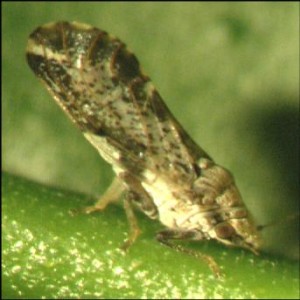Citris Threat: Asian Physillid
 Question from Julie:
Question from Julie:
I am new to your site and appreciated reading through your info. on the leaf miner and worm castings for ants. I am concerned about a new citris threat, asian physillid??? and a greening disease called “yellow dragon”. How prevalent is this new disease. There seems to be no cure.
Answer from Pat:
Asian Citrus Psyllid is a devastating pest of citrus new to California and recently found furthest north in Mission Hills San Diego, having invaded or been brought in accidentally from Mexico. It is still in the early stages of proliferation in California, not yet in wide distributed, but the fear is that it is spreading northward. This exotic pest spreads a citrus disease that seems to have many names, including “yellow dragon disease” or (more frequently) “Huanglongbing” (HLB), Chinese for “Yellow Shoot Disease”, and formerly called “Citrus Greening”. (Eventually, among other symptoms, this disease makes fruit turn green and bitter, thus unpalatable.)
HLB is an extremely serious bacterial disease caused by several species of Candidatus Liberibactus. There is no known cure. The onset of symptoms of HLB do not show for some time after the original infection, thus in its early stages the disease is difficult to diagnose. Infected trees first show signs that look like mineral deficiency, but as the disease slowly advances it becomes clear that, instead of mineral deficiencies having discolored the leaves, it is HLB disease that has damaged them. As the disease progresses, the more devastating symptoms are seen, and these include green bitter fruit that cannot be eaten and drooping yellow new growth all over the top and sides of the tree plus the eventual decline and death of the tree. Here are two links which will lead you to extensive descriptions and discussions of this disease and the threat it poses to local agriculture. There are also photos of damaged fruit and leaves: Asian Citrus Psyllid Quarantine Information and http://www.cdfa.ca.gov/phpps/acp/
If you think your citrus tree or trees are suffering from this pest or disease, contact your local University Extension or phone 1-800-491-18799 and report the problem.
I wish I could suggest an organic control but I cannot offer any helpful suggestions other than to hang sticky yellow traps onto the tree and hope pests go to these traps first. You could apply the bagged dry earthworm casings on top of the ground under the tree to help control pest insects but this action won’t do anything to control the disease. However, maintaining a good organic soil and releasing beneficial insects might help, since beneficials control many pests and could also help control Asian Citrus Psyllid.
You have already read my recommendations of earthworm castings for insect control, but unfortunately, whereas the chitinase in earthworm castings attacks insects, it won’t help fight a bacterial disease. Once Asian Citrus Psyllid has inoculated a tree with bacterial disease, I do not know of any way to get at that bacteria unless it would be to inoculate the tree with a beneficial bacteria that attacks and kills the damaging bacteria. Finding such a bacteria would require extensive research. A better way would be to discover and grow resistant varieties of citrus. When an entire plantation of citrus or many plantations, are infected with a particular disease it is not outside the realm of possibility that certain trees could be found that do not succumb to the problem since they have a natural resistance. But bacteria is different from fungus. Grafting citrus varieties onto resistant root stocks is a major way to control fungus diseases, such as phytophthera, but in the case of bacterial diseases, it seems as if an entirely resistant variety of tree would need to be found and then grown in sufficient quantity to replace the sick trees. We can only hope that growers of citrus worldwide will watch for resistant trees. The problem is a bit daunting, since it appears a resistant strain for each citrus variety would need to be found. Scion wood taken from resistant trees could be used in future to create resistant varieties of citrus to save the citrus industry, plus of course our home-grown fruit.

